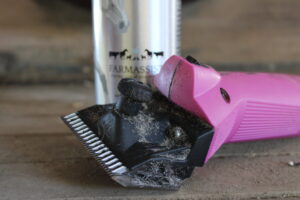08 Jun Clipping and Bacteria

Clipping and Bacteria
There are many reasons why we clip our horses, but the most common reasons are for health and comfort. It’s always best to start clipping with a clean horse and sharp blades but even then, the tiny loose hairs produced by clipping cause itchiness and the open hair follicles are a haven for bacteria to get in. Folliculitis starts when the hair follicles are damaged which can occur from clipping. Commonly we call this clipper rash.
Washing your horse post clipping with Farmassist Health Antibacterial Equine Wash not only removes the loose itchy hairs but it limits the ability of bacteria entering the open or damaged hair follicles helping to eliminate clipper rash.
Let’s look at the make-up of your horse’s skin.
Epidermis: The epidermis is the thickest outer layer of skin that is composed of several layers of cells. It provides a protection barrier from foreign substances such as bacteria. The epidermis of a horse is only 1mm thicker than that of a human.
Dermis: The dermis is the next layer which supports and nourishes the epidermis and contains the blood vessels which regulate skin and body temperature and supply the epidermis with nutrients. The thickness of the dermis ranges between 1 and 6mm depending on location within the body.
Hypodermis: This subcutaneous layer is the inner most major layer of skin which contains subcutaneous fat and muscles.

Hair follicles:
The dermis contains connective tissue, hair follicles, blood vessels and sweat glands.
Horses have around 1000 hairs per square centimeter.
Folliculitis:
Folliculitis is a bacterial, fungal or mixed infection of the hair follicle. Staphylococcus folliculitis causes inflammation of the hair follicle resulting in small clusters of small red lumps or pustules developing around the hair follicles on the outer skin surface (epidermis).
Bacterial infections of the hair follicle are secondary to cutaneous trauma (injuries that are related to the skin i.e., cuts, abrasions and lacerations). Abrasions are trauma to the outer layers of the skin and hair due to friction with a foreign object i.e., a horse rubbing against a rail.
Trauma to the skin is largely unavoidable when owning horses. Controlling the treatment with Farmassist Health products ensure that your horses’ skin can repair without nasty bacteria inhibiting the recovery ensuring a happy, healthy horse.



No Comments